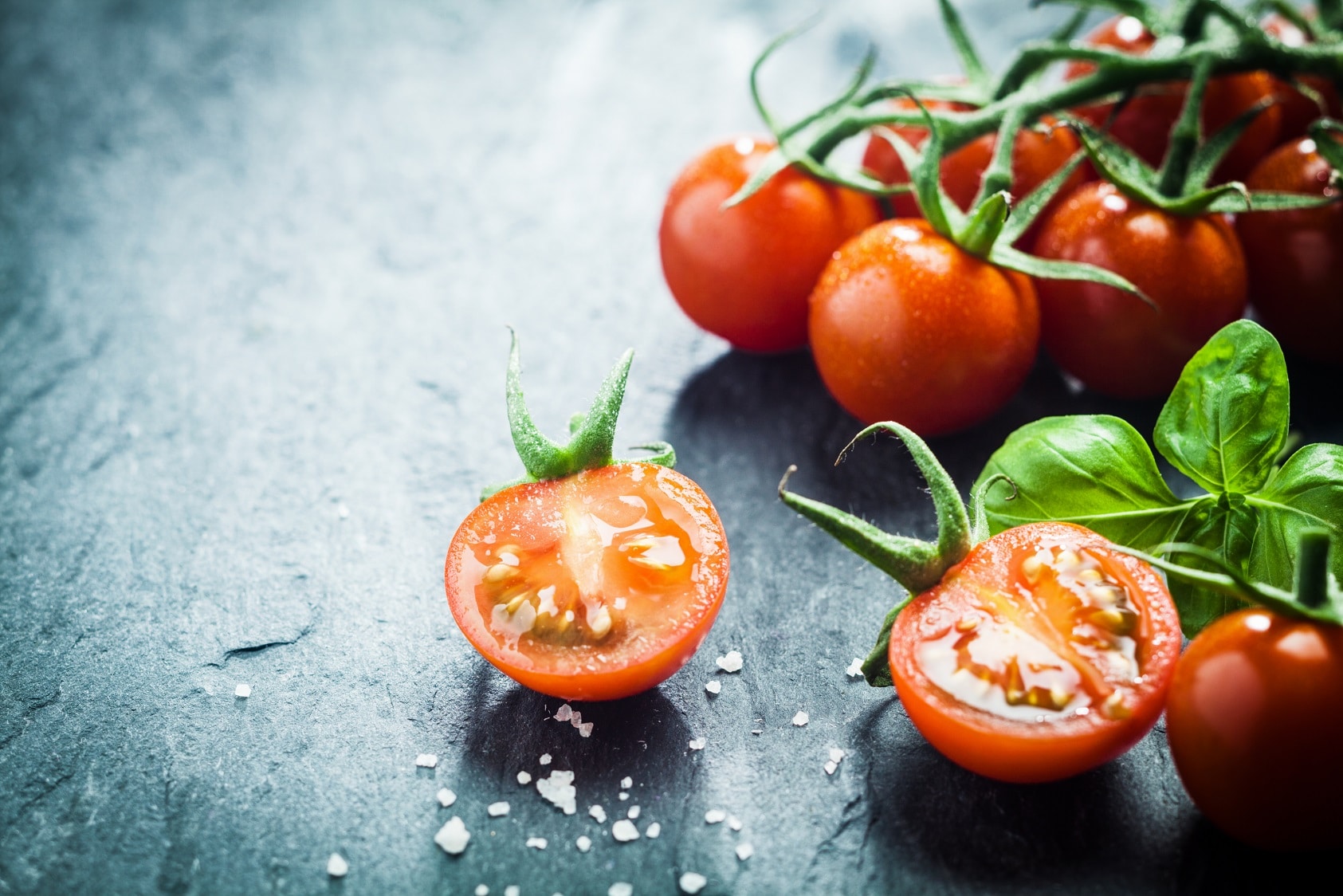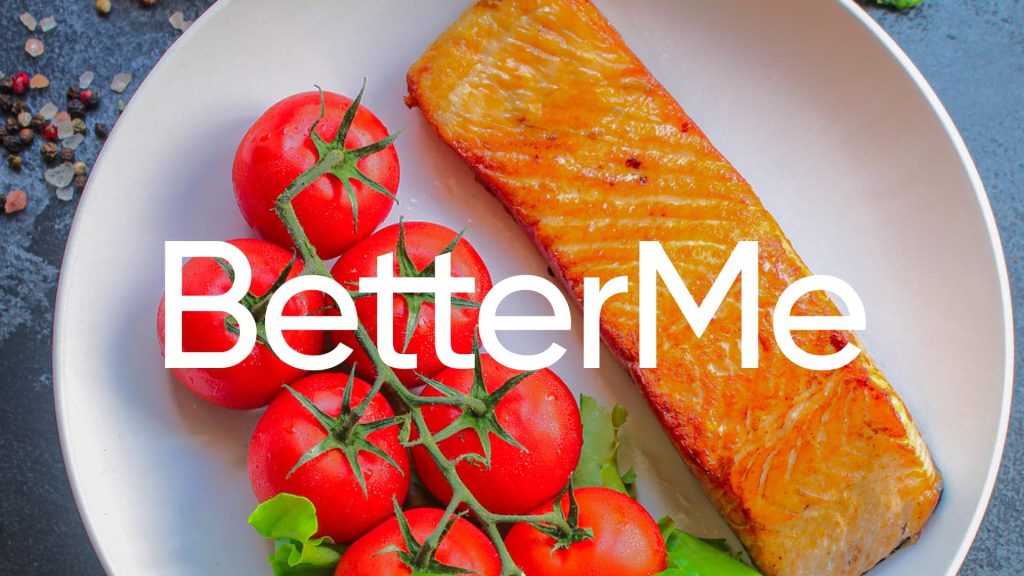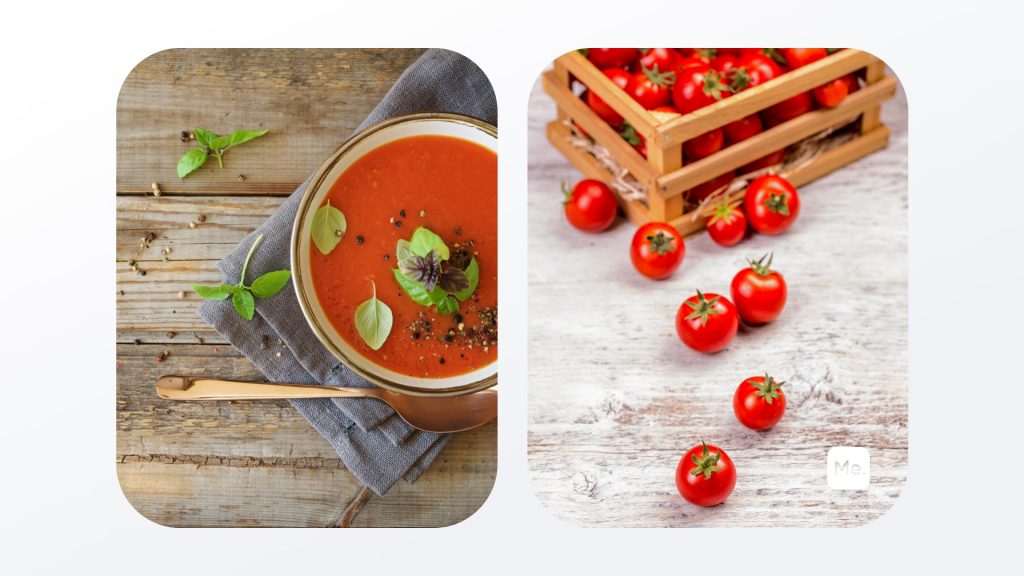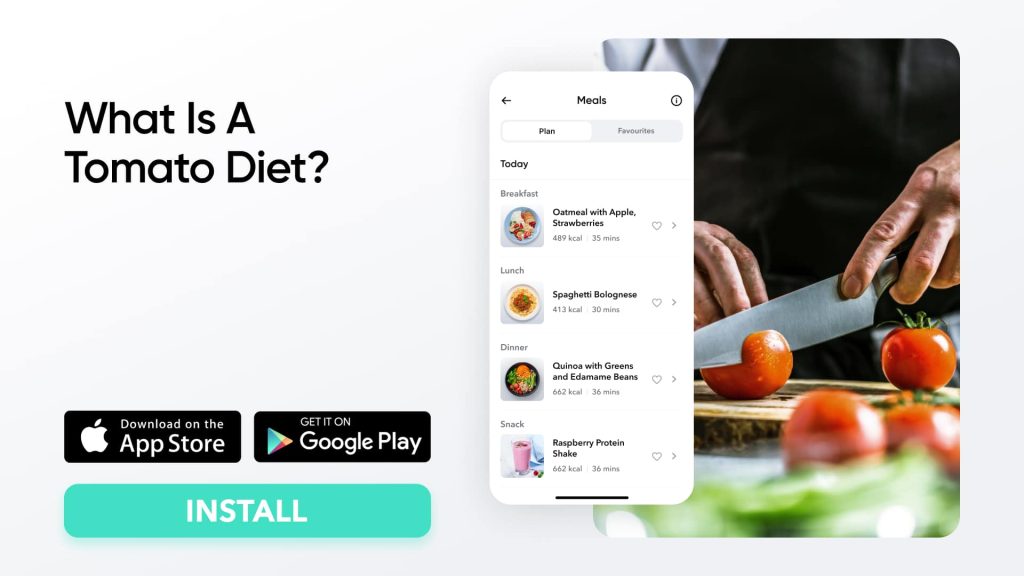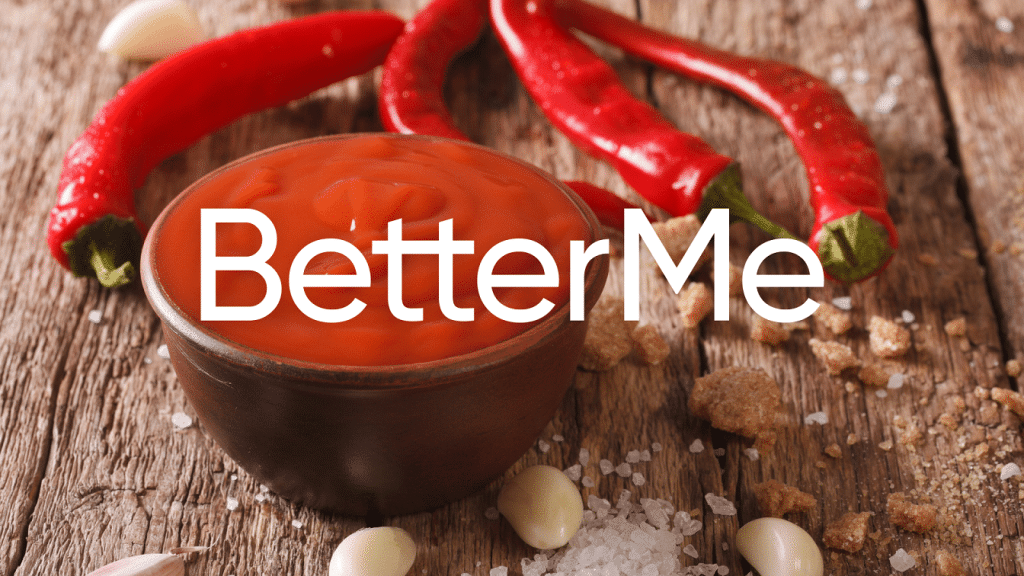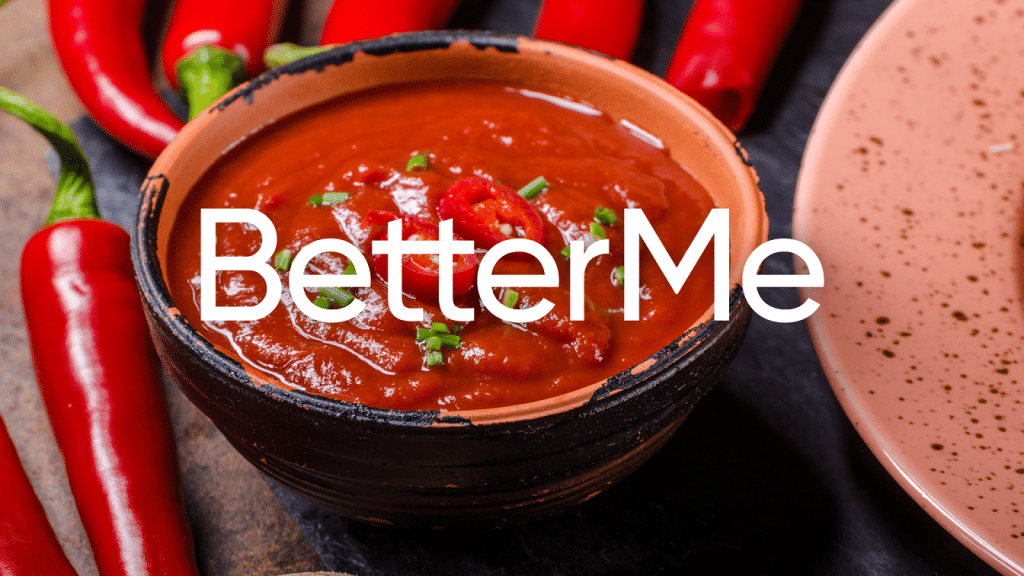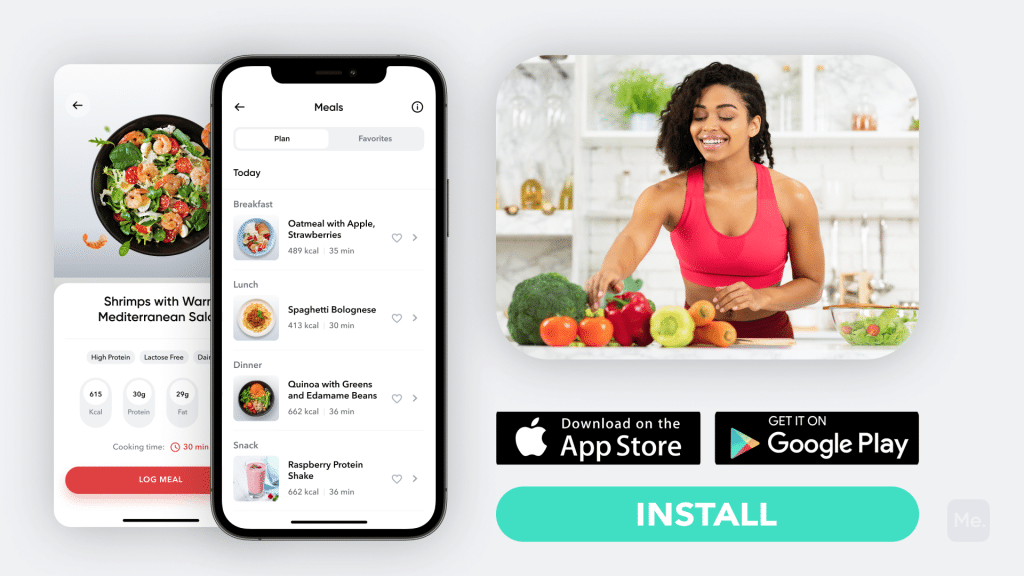Tomatoes are one of the easiest and most versatile vegetables to grow. They can be grown in containers, raised beds, or large garden plots. In the kitchen, they are a common ingredient in many dishes, from pasta sauces to salads. But what are the nutritional benefits of tomatoes? And how can you get the most out of this delicious vegetable? In this article, we will answer these questions, tell you about benefits of tomatoes and more.
Tomatoes Nutrition Facts
According to the USDA, a small 100-gram raw tomato contains the following nutrients (16):
- Calories: 18
- Water: 95%
- Protein: 0.9 grams
- Carbs: 3.9 grams
- Sugar: 2.6 grams
- Fiber: 1.2 grams
- Fat: 0.2 grams
Tomatoes also contain several beneficial nutrients and antioxidants, including (5):
- Alpha-lipoic acid – an antioxidant that helps prevent free radical damage to cells
- Lycopene – an antioxidant that protects blood vessels from oxidative stress and reduces the risk of heart disease.
- Choline – an essential nutrient that is important for cell membranes and communication between neurons.
- Folic acid – helps convert food into energy, builds DNA and new cells, and reduces the risk of neural tube defects in developing fetuses.
- Vitamin B6 – helps maintain brain function, keeps the nervous system healthy, supports immune function, red blood cell function, and many more functions.
- Vitamin K – helps with blood clotting and bone growth.
- Vitamin A – an antioxidant that helps keep eyes and skin healthy, and supports the immune system.
- Beta-carotene – an antioxidant that helps protect against free radicals and protects vision.
- Lutein – an antioxidant that helps protect the retina and prevents age-related vision loss.
Benefits Of Tomatoes
Eating tomatoes and tomato-based products has the following benefits:
Benefits Of Tomatoes: Heart Health
Lycopene, a carotenoid found in tomatoes, has been shown to promote heart health. lycopene may help protect the blood vessels from damage caused by free radicals and improve blood circulation (8).
Bone Health
Tomatoes are a good source of Vitamin K, which is important for bone health. Vitamin K helps to build and maintain strong bones by increasing calcium absorption (19).
Benefits Of Tomatoes: Cancer Prevention
Tomatoes are a rich source of antioxidants, including lycopene, beta-carotene, and vitamin C. These antioxidants may help prevent cancer by scavenging harmful free radicals from the body (12).
Eye Health
Tomatoes are a good source of lutein and zeaxanthin, two carotenoids that help protect the eyes from age-related damage (2).
Skin Health
The antioxidant lycopene also helps protect the skin from UV radiation damage. In fact, animal studies have found that consuming tomatoes may reduce the risk of skin cancer (18).
Benefits Of Tomatoes: Healthy Digestion
Tomatoes are a good source of dietary fiber and can help promote healthy digestion by keeping your intestines regular. In addition, tomatoes contain pectin, a soluble fiber that helps control cholesterol levels and improve blood sugar regulation in people with diabetes (7).
Anti-Inflammatory Benefits
Tomatoes contain high amounts of vitamin C, which is a powerful antioxidant that can fight oxidative stress and inflammation (5).
Read More: Tomato Diet: Unsustainable Weight Loss Trend Alert!
Prostate Health
Lycopene may also help prevent prostate cancer by acting as an antioxidant and preventing DNA damage(14).
Benefits Of Tomatoes: Increased Energy Levels
Lycopene may increase energy levels by reducing the effects of free radical damage on our cells’ mitochondria (the part of cells that turns food into energy) (13).
Weight Loss
Tomatoes are rich in fiber, which can help us feel full after eating and may promote weight loss (7). This is especially true when they are eaten in salads, smoothies, and other nutrient-dense meals.
Improved Lung Health
Consuming tomatoes regularly may help improve lung health by reducing inflammation and the risk of asthma and other respiratory diseases. That may be because lycopene, lutein, and zeaxanthin, among other antioxidants, can prevent damage to the lungs caused by environmental toxins and other pollutants (10).
Benefits Of Tomatoes: Improved Oral Health
Lycopene may help reduce the risk of oral cancer (17). In addition, the antioxidant quercetin protects against periodontal disease caused by inflammation (11).
Side Effects Of Eating Too Many Tomatoes
Like any other food, eating too many tomatoes can have negative consequences.
Damage Teeth Enamel
Tomatoes are acidic, so eating them in large amounts may erode tooth enamel over time. This is especially true if you brush your teeth soon after eating tomatoes.
Pesticide Residue
Tomatoes are commonly treated with pesticides. According to the Environmental Working Group’s (EWG) 2021 list of fruits and vegetables with the highest levels of pesticide residues, tomatoes come 10th (6). Buying organic tomatoes may reduce the risk of pesticide exposure. Otherwise, be sure to wash your tomatoes thoroughly before eating them.
Upset Stomach Or Diarrhea
Eating too many tomatoes can lead to stomach rumbling, bloating, nausea, and diarrhea. This is especially true for people who may be sensitive to acidic foods like tomatoes. This includes those with gastroesophageal reflux disease (GERD) (3).
Allergies
Some people experience allergic reactions to tomatoes (15). Symptoms of tomato allergy may include itchy skin, a runny nose, sinus congestion, and wheezing.
If you wish to cinch your waist, tone up your bat wings, blast away the muffin top – our fitness app was created to cater to all your needs! BetterMe won’t give excess weight a chance!
How Many Tomato Varieties Are There?
There are thousands of tomato varieties and products. Here are some common types:
Slicing Tomatoes
These large tomatoes vary in color, including red, yellow, orange, green, and even pinkish white. They’re usually juicy with few seeds. The majority of slicing tomatoes grown for commercial use belong to the species Lycopersicon lycopersicum.
Cherry Tomatoes
These small, round tomatoes are usually red, but can also be yellow, orange, or green. They’re packed with flavor and sweetness and are a popular choice for salads and snacks.
Tomatillos
These small green tomatoes are related to the larger tomato plant but have a different flavor and texture. They have a thin, papery husk that covers the outer flesh.
Heirloom Tomatoes
These colorful varieties of tomatoes may be red, yellow, purple, or black. They have a different taste and appearance as compared to the more commercially produced varieties.
Green Tomatoes
These unripe tomatoes are usually green in color and hard to the touch. They’re typically used as an ingredient for dishes like fried green tomatoes rather than eaten on their own.
Tomato Sauce
This sauce is made from tomatoes, herbs, and spices. It’s a common ingredient in Italian and Mexican cuisine.
Pizza Sauce
This sauce is made from crushed tomatoes, herbs, and spices. It’s a common topping for pizza.
Salsa
This sauce is made from tomatoes, onions, peppers, and other seasonings. It’s a popular dip for chips and other snacks.
Sun-Dried Tomatoes
These dried tomatoes are packed with flavor and rich in nutrients, including fiber, iron, antioxidants, and vitamin E.
Tomato Paste
This concentrated paste is made by cooking down tomatoes until it becomes thick. It has a strong tomato flavor that can be used as an ingredient or for canning.
Tomato Ketchup
This condiment is made from tomatoes and spices like vinegar, sugar, and salt. It’s a popular topping for burgers and fries.
Read More: Calorie Deficit Diet Plan: Why And How Eating Less Can Help You Lose Weight
How To Eat More Tomatoes
There are many ways to enjoy tomatoes in your diet. Here are a few ideas:
- Add diced tomatoes to pasta sauce, salsa, or chili.
- Serve sliced tomatoes with salad greens and crumbled cheese.
- Make a simple tomato soup by simmering chopped tomatoes with stock and herbs.
- Puree cooked tomatoes with olive oil, garlic, and herbs to make a quick sauce.
- Add canned diced tomatoes to canned black beans for a quick and healthy black bean dip.
- Make fresh smoothies using fresh or frozen chopped tomatoes.
- Make a quick and healthy bolognese sauce by simmering ground beef with diced tomatoes.
- Add sliced tomatoes to sandwiches and wraps
- Dip cherry tomatoes in hummus or other dips.
- Add diced tomatoes to scrambled eggs or omelets.
- Make quick soups by simmering chopped tomatoes with stock, herbs, and spices.
- Juice fresh tomatoes for a healthy alternative to sugary drinks.
How To Buy And Store Tomatoes To Preserve Nutrients
Tomatoes are available year-round in most supermarkets, but they are at their peak between June and September. When buying tomatoes, choose those that are firm to the touch without any soft spots.
To preserve nutrients and flavor, store fresh tomatoes on your countertop rather than in the fridge. Sometimes you might have to store them in the fridge, but make sure to eat them within a couple of days.
Store fresh tomatoes away from apples and bananas, as these fruits give off ethylene gas, which can cause tomatoes to ripen more quickly.
If you have a lot of tomatoes on hand, you can also freeze them for use in winter soups and stews. To do this, first blanch the whole tomatoes by dipping them in boiling water for 30 seconds. Then transfer to an ice bath until cool. Remove the skins and chop the tomatoes into the desired size. Pack the chopped tomatoes into airtight containers or freezer bags, and freeze.
BetterMe is your fast-track ticket to a long-lasting weight loss! Tailor your fitness journey and maximize your results with just a couple of swipes!
Easy Tomato Recipes
Below are simple tomato recipes you can try out:
Roasted Tomato Basil Soup (4)
This soup is great to have for a light lunch or dinner. You can accompany it with whole wheat bread or French baguette. It’s vegan and gluten free.
Ingredients:
- 3 lb Roma tomatoes halved
- 2 to 3 carrots, peeled and diced
- Extra virgin olive oil
- Salt and pepper
- 2 medium yellow onions, chopped
- 5 garlic cloves, minced
- 1 cup canned crushed tomatoes
- 2 oz fresh basil leaves
- 3 to 4 fresh thyme sprigs 2 teaspoon thyme leaves
- 1 teaspoon dry oregano
- ½ teaspoon paprika
- ½ teaspoon ground cumin
- 2 ½ cups water
- Lime juice (optional)
Directions:
- Preheat the oven to 450°F.
- In a large bowl, mix the tomatoes and carrots. Add some olive oil, salt and black pepper then toss to combine.
- Transfer to a baking tin and spread it. Roast in the oven for about 30 minutes. When ready, take it out and let it cool for about 10 minutes.
- Transfer the roasted carrots and tomatoes to a food processor. Add in some water then blend until smooth.
- In a cooking pot, heat 2 tablespoons of olive oil over medium heat. Add the onions and cook for 3 minutes then put in the garlic and cook for a few more minutes or until golden brown.
- Pour the tomato-carrot mixture into the pot. Add the crushed tomatoes, water, thyme, basil, and the spices. Bring to a boil then let the brothers cook over low heat for another 20 minutes.
- Remove the thyme sprigs and serve. You can drizzle some lime juice if you wish to.
You can store any leftovers in the refrigerator in an air-tight container for 3 to 4 days. You can also freeze the soup for 3 to 6 months. I’m the case you prefer your soup lighter, you can add in more water instead of the 2 ½ cups. If you like it hot, add in some pepper and blend with the roasted tomatoes and carrots.
Servings: 6
Nutritional info: 105 calories, 23.4g carbs, 4.3g protein, 0.8g fat, 93.6mg sodium
Over Baked Tomatoes With Mozzarella And Parmesan Cheese (1)
Cheese is an all time favorite and when combined with tomatoes they are the perfect appetiser. It’s a simple recipe so you don’t have to be a pro in the kitchen to prepare this dish.
Ingredients:
- 4 roma tomatoes sliced
- 1 cup shredded mozzarella cheese
- 1 cup shredded parmesan cheese
- 1/2 cup fresh basil chopped
- Extra virgin olive oil
Directions:
- Preheat the oven to 400°F.
- Place the tomato slices on a baking sheet lined with parchment paper.
- Top each tomato with some parmesan cheese then some Mozzarella.
- Sprinkle the basil on top of the tomatoes then lightly drizzle with the extra virgin olive oil.
- Bake for about 8 to 10 minutes. Make sure the cheese is melted.
- Turn off the oven and Broil for 3 minutes to brown the cheese.
- Serve and enjoy!
Servings: 4
Nutritional info: 193 calories, 3g carbs, 15g protein, 12g fat, 579mg sodium
Mediterranean Tomato Feta Salad (9)
You can have this salad as a midday snack or alongside your favorite meal. You can also have it as lunch with some whole wheat bread if you are trying to reduce your calorie consumption. It’s packed with flavor because of the fresh herbs so you’ll definitely enjoy it.
Ingredients:
- 6 to 7 medium ripe tomatoes, sliced into wedges (on-the-vine tomatoes or heirloom tomatoes preferred)
- 1 medium red onion, halved, then thinly sliced
- 3 garlic cloves, minced
- 1 cup fresh parsley leaves, chopped
- 1 cup chopped fresh dill, chopped
- 2 ½ teaspoon ground sumac
- Kosher salt, to your liking
- Black pepper
- 1 lemon, juiced
- 2 teaspoon white wine vinegar
- ⅓ cup extra virgin olive oil
- Feta cheese (optional)
Directions:
- In a large mixing bowl, add the tomatoes, herbs, onion and garlic
- Add the Kosher salt, sumac, and sprinkle some hot pepper. Add the white wine vinegar, lemon juice and olive oil. Toss to combine. You can taste and adjust the seasoning to your preference.
- Transfer to a serving bowl. Let it sit at room temperature for a few minutes.
- Top with pieces of Feta cheese and enjoy!
Servings: 6 (as a salad before dinner), 4 (as a lunch entree)
Nutritional info: 128.3 calories, 5.1g carbs, 1.g protein, 10.6g fat
The Bottom Line
Tomatoes are a nutritional powerhouse and are a great addition to any diet. They’re low in calories and high in nutrients, including antioxidants and vitamin C. Tomatoes can be eaten fresh or cooked, and there are many ways to enjoy them. When buying tomatoes, look for those that are firm to the touch and store them on your countertop. If you have a lot of tomatoes, you can freeze them for use in winter soups and stews.
Get your personalized
meal plan!
DISCLAIMER:
This article is intended for general informational purposes only and does not serve to address individual circumstances. It is not a substitute for professional advice or help and should not be relied on for making any kind of decision-making. Any action taken as a direct or indirect result of the information in this article is entirely at your own risk and is your sole responsibility.
BetterMe, its content staff, and its medical advisors accept no responsibility for inaccuracies, errors, misstatements, inconsistencies, or omissions and specifically disclaim any liability, loss or risk, personal, professional or otherwise, which may be incurred as a consequence, directly or indirectly, of the use and/or application of any content.
You should always seek the advice of your physician or other qualified health provider with any questions you may have regarding a medical condition or your specific situation. Never disregard professional medical advice or delay seeking it because of BetterMe content. If you suspect or think you may have a medical emergency, call your doctor.
SOURCES:
- Baked Tomatoes with Mozzarella & Parmesan (Cheesy Oven Roasted Tomatoes) (2018, thecookierookie.com)
- Dietary Sources of Lutein and Zeaxanthin Carotenoids and Their Role in Eye Health (2013, mdpi.com)
- Don’t eat tomatoes: patient’s self-reported experiences of causes of symptoms in gastro-oesophageal reflux disease (2010, academic.oup.com)
- Easy Roasted Tomato Basil Soup (Vegan, GF) (2020, themediterraneandish.com)
- Enhancing the Health-Promoting Effects of Tomato Fruit for Biofortified Food (2014, hindawi.com)
- EWG’s 2021 Shopper’s Guide to Pesticides in Produce (2021, ewg.org)
- Health benefits of dietary fiber (2009, academic.oup.com)
- Lycopene and Vascular Health (2018, frontiersin.org)
- Mediterranean Tomato Feta Salad Recipe (2021, themediterraneandish.com)
- Nutrition and Respiratory Health—Feature Review (2015, mdpi.com)
- Quercetin Prevents Oxidative Stress-Induced Injury of Periodontal Ligament Cells and Alveolar Bone Loss in Periodontitis (2021, ncbi.nlm.nih.gov)
- The Benefits and Risks of Certain Dietary Carotenoids that Exhibit both Anti- and Pro-Oxidative Mechanisms—A Comprehensive Review (2020, mdpi.com)
- The importance of antioxidants which play the role in cellular response against oxidative/nitrosative stress: current state (2015, biomedcentral.com)
- The Potential Role of Lycopene for the Prevention and Therapy of Prostate Cancer: From Molecular Mechanisms to Clinical Evidence (2013, mdpi.com)
- Tomato allergy: clinical features and usefulness of current routinely available diagnostic methods (2013, pubmed.ncbi.nlm.nih.gov)
- Tomatoes, raw (2020, fdc.nal.usda.gov)
- Tomatoes, Tomato-Based Products, Lycopene, and Cancer: Review of the Epidemiologic Literature (1999, academic.oup.com)
- Tomatoes protect against development of UV-induced keratinocyte carcinoma via metabolomic alterations (2017, nature.com)
- Vitamin K and bone health (2001, pubmed.ncbi.nlm.nih.gov)
